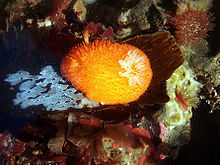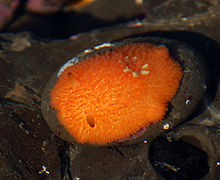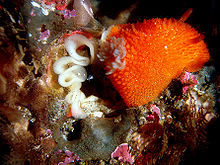- Orange-peel doris
-
Orange-peel doris 
Acanthodoris lutea Scientific classification Kingdom: Animalia Phylum: Mollusca Class: Gastropoda Family: Onchidorididae Genus: Acanthodoris Species: A. lutea Binomial name Acanthodoris lutea
MacFarland, 1925The orange-peel doris, (Acanthodoris lutea), is a species of nudibranch or sea slug, a shell-less marine opisthobranch gastropod mollusk in the family Onchidorididae.
This species is the largest of the northeastern Pacific acanthodorids. It is a common species, and it is very noticeable because of its bright coloration, which is aposematic. The species name "lutea" is a Latin word which means an orange-yellow color.
As for the generic name, "acantho" comes from the Greek word meaning spiny, and "doris" is the name of an ancient Greek sea nymph.
Contents
Description
This nudibranch grows to about 30 mm in length. It has a bright orange papillated dorsum covered with yellow specks. As is the case with many nudibranchs, this bright coloration is thought to be a reminder to would-be predators of its distasteful nature, an example of aposematic coloration.
When handled, these slugs often smell of sandalwood.
Distribution
This dorid nudibranch lives on the Pacific coast of North America from Cape Arago, Oregon to northern Baja California, Mexico.
Habitat
The orange-peel doris lives in the intertidal and subtidal zones on rocky shores.
Life habits
Acanthodoris lutea feeds on encrusting bryozoans. It turns the chemicals received from the bryozoan food into a noxious metabolite which is toxic to possible predators (Morris et al. 1980).
This species is aposomatically colored, warning predators of this toxic deterrent. If you handle this dorid you will smell the deterrent chemical on your fingers: it has the pungent aroma of sandalwood.
References
- Behrens D.W., 1980, Pacific Coast Nudibranchs: a guide to the opisthobranchs of the northeastern Pacific, Sea Challenger Books, Washington
External links
Categories:
Wikimedia Foundation. 2010.



